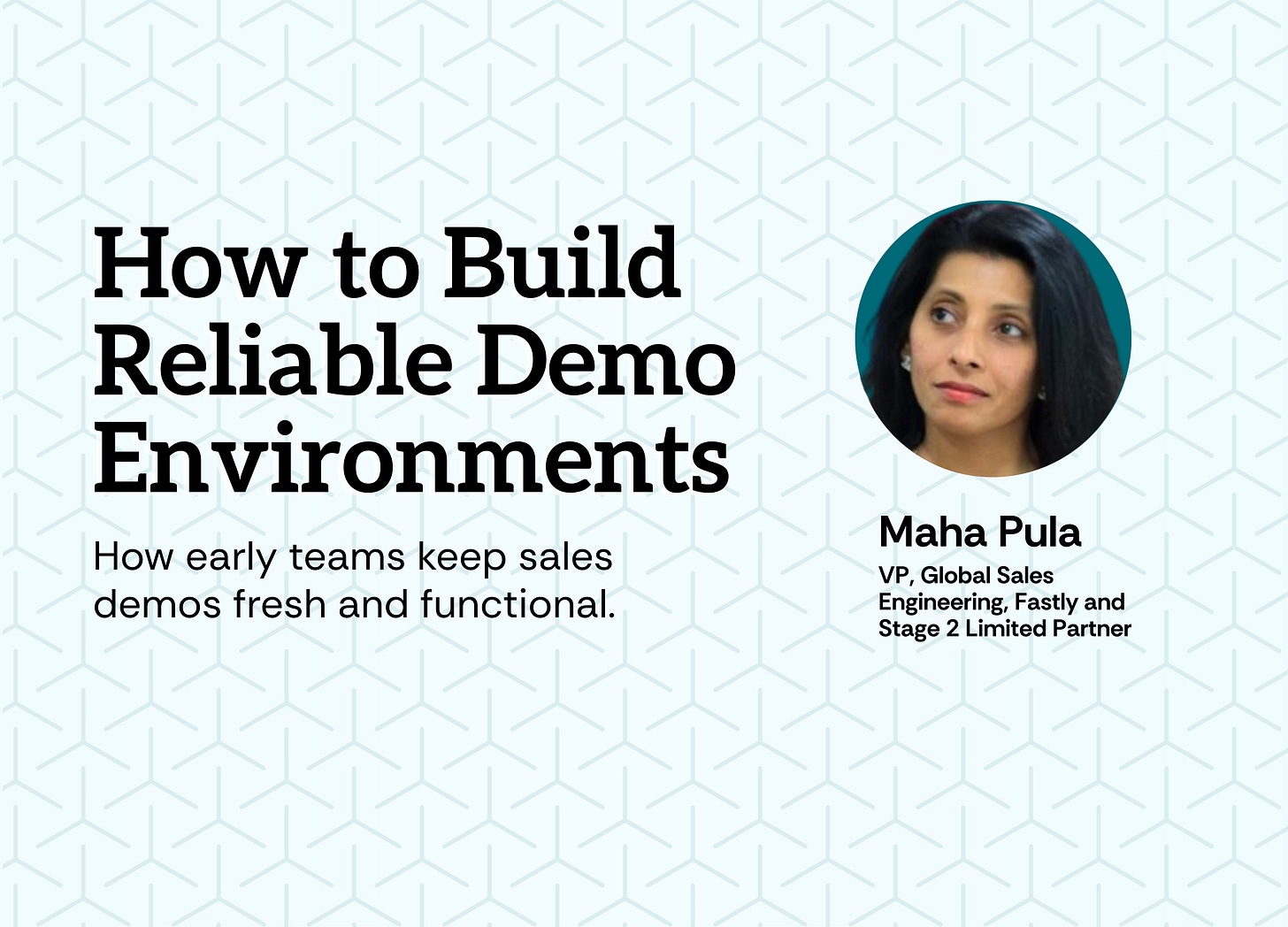How to Build Reliable Demo Environments
How startup teams can keep sales demos fresh and functional.
DEAR STAGE 2: We’re a seed-stage company and looking for advice on managing our demo environments and ensuring our sales team has access to the latest features and a current data set. How do other companies manage this? ~DEMO TO WIN
DEAR DEMO TO WIN: It’s a fair question and a surprisingly tricky one to get right. Over time, the demo environment becomes a tangle of stale data, outdated features, or worse, it breaks mid-call. To help you get ahead of these challenges, I gathered advice from a few portfolio companies that’ve solved this in different ways and asked Maha Pula, Stage 2 LP and experienced Solution Consulting leader, to share her take for scale.
Here’s what we heard:
1. Give Every Rep Their Own Space
One early-stage company created individual demo environments for each rep. Why?
Reps can customize their space to suit their specific pitch, the vertical or market segment they are selling to, the use case, and their demo style.
They can use the account for a few demos, trigger specific workflows, and when they need a “clean” account, they just hit a reset button that doesn’t impact anyone else on the team.
That reset button took some work on the back end and triggered a workflow: it actually generates a new environment using a copy of base demo org that is maintained with fresh data monthly (so dates are always current).
💡 Key takeaway: Investing upfront in automation saves time and chaos later. Giving reps the ability to create a new account and refresh data without long delays or devoted engineering time is worth the upfront investment.
2. Treat Demo Data Like a Product
Data quality is where many teams struggle. One sales leader shared three essential lessons:
Use a separate sandbox. Running demos in production? Not worth the stress. Sandbox environments help avoid nasty surprises (like hitting API limits).
Load smart from the start. Generating demo data manually is painful. Try using ChatGPT to generate rich, realistic scenarios that map to real customer use cases.
Prioritize features, not perfection. Reps will always nitpick the data. Focus on showcasing key features v. simulating a perfect live account.
💡 Key takeaway: Think of demo data as something you invest in. Ideally should build it once, test it hard, and let it evolve.
3. Deploy New Features Behind Feature Flags
Finally, one team solved the “show what’s coming” problem without disrupting their production accounts by using feature flags.
They treat their demo store like any other customer in production. Need a demo account? Provision an instance, just like you would a new customer account.
When a new feature is almost ready, they deploy it behind a toggle—and turn it on only in the demo environments until it’s ready for broad release.
Critically, you need a system to ensure inactive demo accounts are being deleted and not building up in the background.
💡 Key takeaway: Feature flags are a smart way to preview what’s coming without the risk of showing half-baked functionality elsewhere.
4. Preparing for Scale
As you move from early demo scrappiness to scaling, Maha offers sharp advice: treat your demo environment like an internal product.
Assign Clear Demo Ownership Early. As your team grows, hire or assign a dedicated resource to own demo automation and maintenance. Their job is to:
Build core demo environments aligned to your most common sales use cases.
Reduce the time SEs spend fixing data or testing scripts.
Work with product and engineering to keep environments current.
Build a Single, Flexible Demo System. Set up one main demo environment that covers your top use cases (you can also create environments based on verticals, segments etc..) and let SEs self-provision additional accounts as needed. Maha recommends automating everything you can: scripts to refresh data, health checks to ensure demos are live, and feature flags to safely showcase upcoming releases. Your goal should be to limit SE time spent customizing demos.
Prioritize Speed and Practicality Over Perfection. When evaluating demo tech or building your own, you want to focus on how fast you can deliver a working demo to your ICP.
When in doubt, go back to your sales team to figure out what’s actually being used. The fanciest environment doesn’t help if reps aren’t using it.
Until next week!



